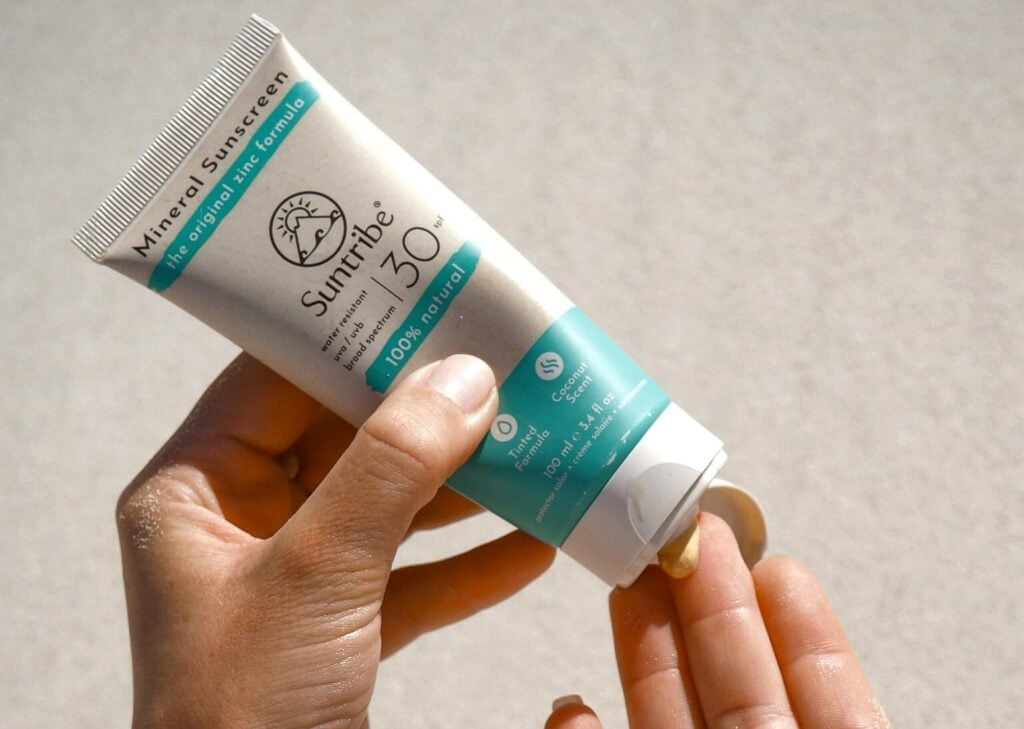The ultimate Guide to UNCOATED NON-Nano Zinc Oxide

By Julia Beyer - March 26, 2024
Zinc Oxide, in its rawest form, is a white powdery mineral with a long history of uses in sun protection. But it has far more benefits than only protecting your skin from sun damage. Since it works like a gentle astringent that also comes with antiseptic action, it works as a topical protectant for skin harm in several areas (we’ll explain in detail what this means). Zinc Oxide is one of the trace minerals that your body requires for the formation and repair of connective tissue and, therefore, supports your skin in healing damaged, dry, and wounded areas. Before we explain in depth why zinc oxide is fantastic for your skin, let’s start by defining nano and non-nano zinc oxide.
What is the Difference between Nano and Non-Nano Zinc Oxide?
Nano means that a particle is smaller than 100mm and, therefore, has to be measured in nanometers, which equals one billionth of a meter. Because of its tiny size, Nano Zinc Oxide can be absorbed into the bloodstream and is traced in human urine. Not only has it been shown to have the potential to affect human health, but it has also been found to have the potential to threaten coral reefs by bleaching them, just as chemical UV filters would. This small size of Zinc Oxide particles is usually used in personal care products because it leaves less of a white cast on your skin than the non-nano version of it.

We prefer to use products that are safe for our skin and our environment, even if that might mean that you see a slight white shimmer when using our sunscreen (don’t worry, we also offer tinted sunscreens). This is the reason why we at Suntribe only use Zinc Oxide in its non nano form. Non Nano means it is larger than 100nm and therefore won’t penetrate your skin. Besides it being the safest option of UV filter to use for human health, it has also been shown to be the safest option for marine life and coral reefs, since Zinc Oxide in its Non-Nano form has been shown not to harm marine wildlife.

What is the Difference between Coated and Uncoated Zinc Oxide?
Coated Zinc Oxide refers to Zinc Oxide coated with an inert substance, most commonly triethoxycaprylylsilane, to make it easier to mix with the other ingredients and (allegedly) prevent the development of free radicals.
At Suntribe, we decided to only use uncoated pharmaceutical-grade Zinc Oxide in our products for the following reasons:
– Triethoxycaprylylsilane and other coatings do not align with our ingredient standards because they are synthetic and not purely natural ingredients. We, therefore, use uncoated Zinc Oxide, which comes closest to the ingredient as it can be found in nature.
– Instead of using coated Zinc Oxide as a shortcut to a more homogeneous formula, we have fine-tuned our production process to mix the uncoated Zinc Oxide with the other ingredients effectively.
– The small amount of free radicals generated by Zinc Oxide can even be contained in the body’s antioxidants, and since we do not use nanoparticles, the Zinc Oxide particles in our sunscreens sit on the outer dead layer of the skin where free radicals can not damage any living cells as confirmed by this study conducted by the Australian government.
– Coatings are not sufficiently effective in decreasing the development of free radicals; in this study, for example, the authors found that the photoreactivity was extremely low for both uncoated and coated Zinc Oxide (whereas it was higher for both coated and uncoated Titanium Dioxide).
– Uncoated Zinc Oxide has been safely used in topical skin care products such as calamine lotion and diaper rash cream for centuries. We add ingredients such as coconut oil and vitamin E to our formulas, which also help absorb any free radicals should they develop and not be absorbed by the skin’s antioxidants already.
Now that we know it’s safe, let’s examine the benefits uncoated Zinc Oxide offers for your skin and health!
The Benefits of Zinc Oxide
1) Zinc Oxide Acts as Natural UV-filter
Zinc Oxide offers natural broad-spectrum protection from UVA and UVB rays, making it the safest UV filter available right now. Scientists recommend it as a safe alternative to chemical UV filters. By filtering harmful UV rays, zinc oxide helps protect cells from damage, halt the aging process, and prevent skin dryness. It is effective after application since it forms a natural barrier between your skin and sunlight.
2) Zinc Oxide Supports Healing
Zinc Oxide diminishes the tenderness that sunburns can cause. It gives chapped skin a soft feeling and helps with skin repair by keeping the area surrounding the wound moist and clean. How cool is that? Zinc oxide helps prevent sunburn; if you get sunburned, it heals faster!
3) Zinc Oxide is a Skin Astringent
Zinc oxide prevents oil formation on the surface of your skin and works effectively to dry excess oils. It also helps to revive your skin’s glow by shrinking large pores and tightening skin to help conceal damages.
4) Zinc Oxide Can Help Treat Acne
Zinc Oxide naturally comates skin irritations and inflammation to keep problems with acne breakouts away. It helps regulate sebum production in the skin and lowers antimicrobial and antibacterial properties, commonly triggering acne. It helps lower inflammation that also occurs as a reaction to this bacteria-induced skin condition. It lowers clogged pores and the possibility of the recurrence of acne.

5) Zinc Oxide Can Help To Relieve Inflammation
Because of its natural properties that provide inflammation relief, Zinc Oxide is often used in products for treating cold sores, skin ulcers, burns, skin irritation, scrapes, and diaper rash. As mentioned above, it helps facilitate the growth of new tissue and the skin’s healing process by preventing further inflammations.
6) Zinc Oxide Prevents Bacterial Infections
Zinc Oxide prevents bacterial infection by keeping your skin dry and reducing the chance of contaminants penetrating it. It also contributes to lowering incidences of infections while also reducing skin permeability and improving your skin’s tightness to keep bacteria away.
Who is Zinc Oxide Good for?
The answer is everyone! Thanks to the anti-inflammatory properties of Zinc Oxide, even people with sensitive skin, rosacea, and acne benefit from the use of it. People with skin discoloration, including melasma and hyperpigmentation, will also benefit from it. While chemical UV filters can contribute to skin discolorations, Zinc Oxide is safe to use and can help to reduce these skin conditions.

Is Zinc Oxide Safe for Marine Life?
Yes, zinc oxide, in its non-nano form, is considered safe for marine life. Unlike some chemical UV filters found in sunscreens, zinc oxide forms a physical barrier on the skin’s surface, reflecting and scattering UV radiation rather than being absorbed into the skin.
Furthermore, non-nano zinc oxide particles are too large to be absorbed by the skin, which in return means they are also too large to be absorbed by marine organisms. This reduced the likelihood of zinc oxide entering the marine food chain and causing harm to aquatic life.
Additionally, zinc oxide is biodegradable and environmentally friendly. Unlike certain chemical UV filters, it does not contain harmful chemicals linked to coral bleaching and other adverse effects on marine life. As a result, zinc oxide is often preferred over mineral sunscreens intended for use in coastal areas and marine environments.
Zinc oxide is considered the safest UV filter available for marine life. This is due to its physical barrier mechanism of protection, lack of absorption into the skin and marine organisms, and its biodegradability. Its eco-friendly characteristics in its non-nano form make it a preferred choice for everyone wanting to protect themselves from the sun without harming the marine environment.
Suntribe's Conclusion About Zinc Oxide
According to the EWG (Environmental Working Group), zinc oxide is an proven-effective ingredient and is considered the safest UV filter available. Since experts consider daily sun protection one of the healthiest skin habits, using a product like mineral day cream, makeup, sunscreen, etc., containing zinc oxide is an excellent choice for all-around daily protection for every type of skin.
At Suntribe, we chose non-nano zinc oxide as our primary mineral UV filter due to its safe and effective protection from harmful UV rays without the risk of skin irritation or allergic reactions. By formulating our 100% natural sunscreens with non-nano zinc oxide, we are able to manufacture sunscreens that are effective, sustainable, and safe for humans and nature alike.
about the author
Hej! I’m Julia, one of the founders of Suntribe. I really enjoy being outdoors as much as possible while going surfing, running or swimming. Over the past few years I have started to live with very few things, and I choose those things carefully. I started Suntribe with my two co-founders because I believe there are better and more environmentally-friendly alternatives to existing cosmetics, and now I am the one developing them!



